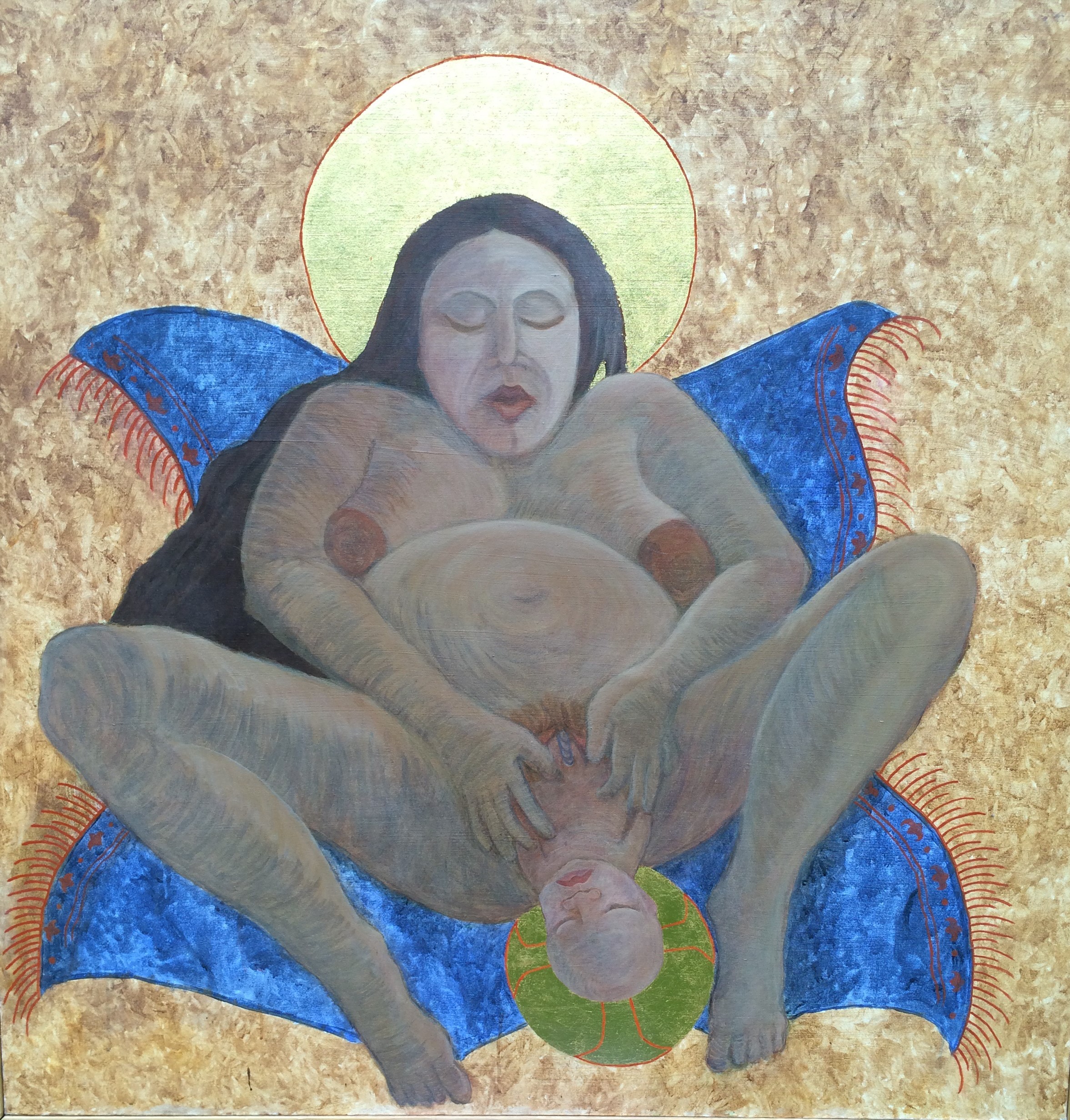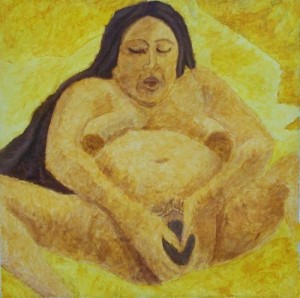Visualizing Sacred Birth in Sara Star’s “The Crowning”

The Crowning, oil on canvas, 5′ x 5′
Copyright 2004, Sara Star. All Rights Reserved
Sara Star has created some of the most powerful art relevant to the visualization of birth. In a previous post, I examined her Study for The Crowning (see also below),a piece Star created in preparation for the painting of her monumental work, The Crowning (above), which measures 5′ x 5′ and depicts the Virgin Mother Mary giving birth to Baby Jesus. Both images are enormously helpful to pregnant women as they prepare in their own journeys of labor and birth. To date, Star has shown The Crowning at a Catholic University, a state college and a small town gallery, and it is my hope that we will show the work here in San Francisco soon.
The Crowning is helpful to pregnant women in several different ways. On a visual level, the painting shows the calm birth of a baby, its mother relaxed and meditative as she labors and her baby emerges. As in the Study for The Crowning, the mother’s eyes are closed and she opens up both gently and strongly, bringing forth the baby with her own hands, unaided and by herself. The warm, ruddy tone of the background, and the soft blue of the pillow on which Mary rests both add to the visual sensation that mother and child are serene in this shared moment of birth.
On a spiritual and emotional level, the image profoundly depicts a sacred figure with whom many women already identify. Regardless of whether the pregnant woman is religious or not, she connects to Mary, a universal symbol of motherhood. As in Kate Hansen’s paintings of mothers as sacred bearers of life, this painting connects its viewers to the cultural ideal of birth and motherhood, symbolized by the Virgin Mary.
In our correspondences, Star has described her making of The Crowning to me. I believe that her deep awareness and respect of the subject matter is also manifest in the hard work she devoted to bringing forth her painting,
I had an idea to paint Mary the Mother of God giving birth to Baby Jesus, according to the life of Mary legends. I referenced several photos from a natural birthing manual called Passages. My process followed that of traditional iconography, but with modern archival materials (acrylic paints on hand built canvas): the verdicco under painting, the style of strokes and the gold leafed halos. The vision was a huge undertaking as I did not know how to paint when I began and my artistic partner and I had already booked the gallery. I enrolled in painting for two terms at University, and I attended weekly workshops under a master iconographer at a local craft store. This painting was for a joint exhibit with my best friend. I recently made an icon for her of Mary, St. Brigit and Baby Jesus in an effort to encourage the conception of her first child. I am happy to say I am now a god(ess)mother.
Star describes elsewhere that she had researched the topic of Mary giving birth prior to painting The Crowning, and yet she found no other images in all of art history that depicted the sacred occurrence. More generally speaking, artist Judy Chicago similarly noticed the lack of art devoted to the topic of birth in Western culture (see posts on Hatching the Universal Egg, Earth Birth, Birth Trinity, andThe Crowning). On her own blog, Star provides her readers with scripture as evidence that Mary gave birth in a peaceful way,
After bring forth her Son, Mary “wrapped Him up in swaddling clothes, and laid Him in a manger” (Luke 2:7), a sign that she did not suffer from the pain and weakness of childbirth. This inference agrees with the teaching of some of the principal Fathers and theologians: St. Ambrose [56], St. Gregory of Nyssa [57], St. John Damascene [58], the author of Christus patiens [59], St. Thomas [60], etc. It was not becoming that the Mother of God should be subject to the punishment pronounced in Genesis 3:16, against Eve and her sinful daughters.
Shortly after the birth of the child, the shepherds, obedient to the angelic invitation, arrived in the grotto, “and they found Mary and Joseph, and the infant lying in the manger” (Luke 2:16). We may suppose that the shepherds spread the glad tidings they had received during the night among their friends in Bethlehem, and that the Holy Family was received by one of its pious inhabitants into more suitable lodgings.
Visualizations of the Virgin Mary as a woman who was peaceful, capable and calm in birthing her baby may help other pregnant women to feel strength and calmness as they approach their own labors.
Sara Star is a neo-romantic artist, currently working in Vancouver, Washington. Her paintings touch on themes of the sacred, the occult, perception, and the body. Feminist images are important to her work. To view more of her work or to contact her, see her blog.
